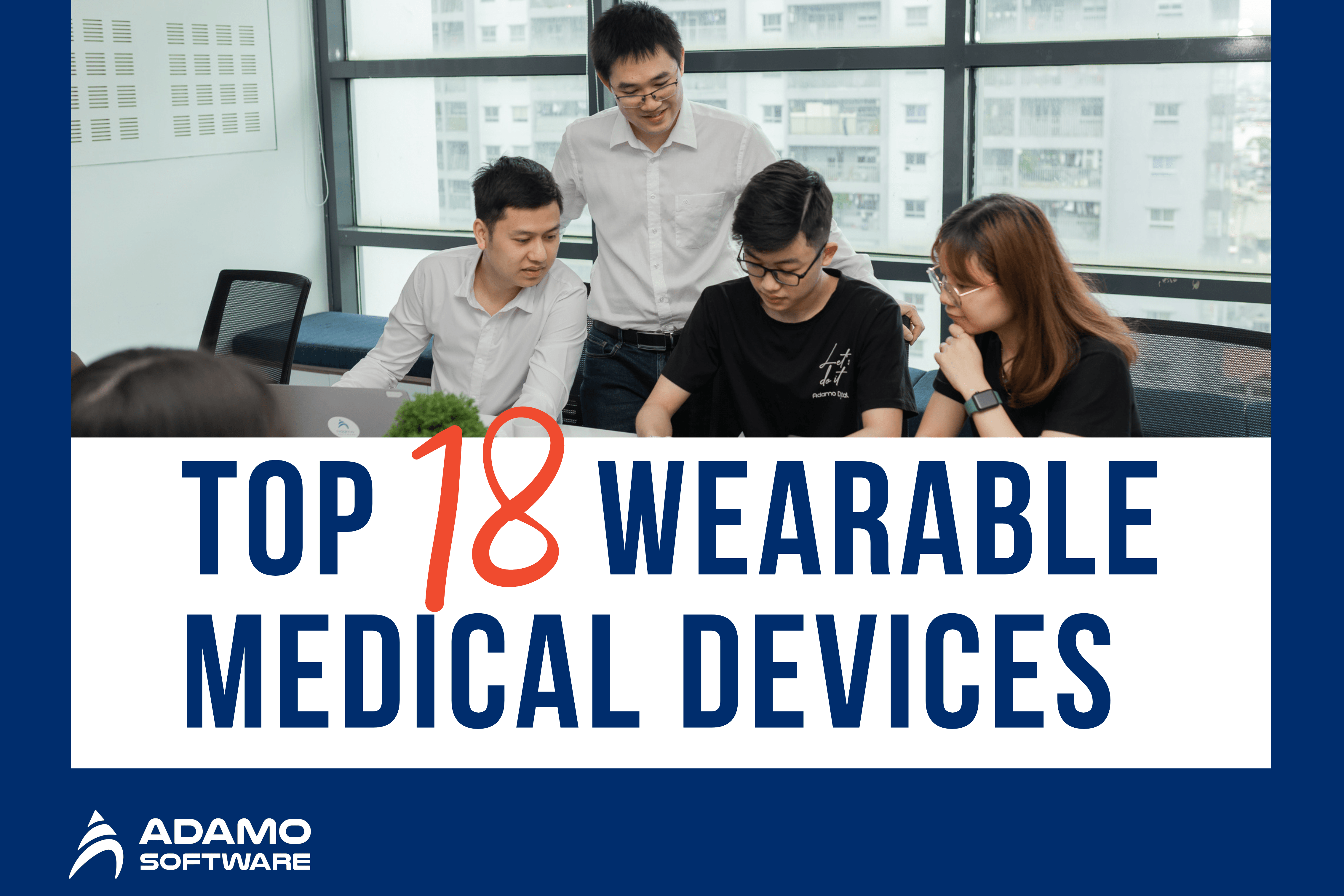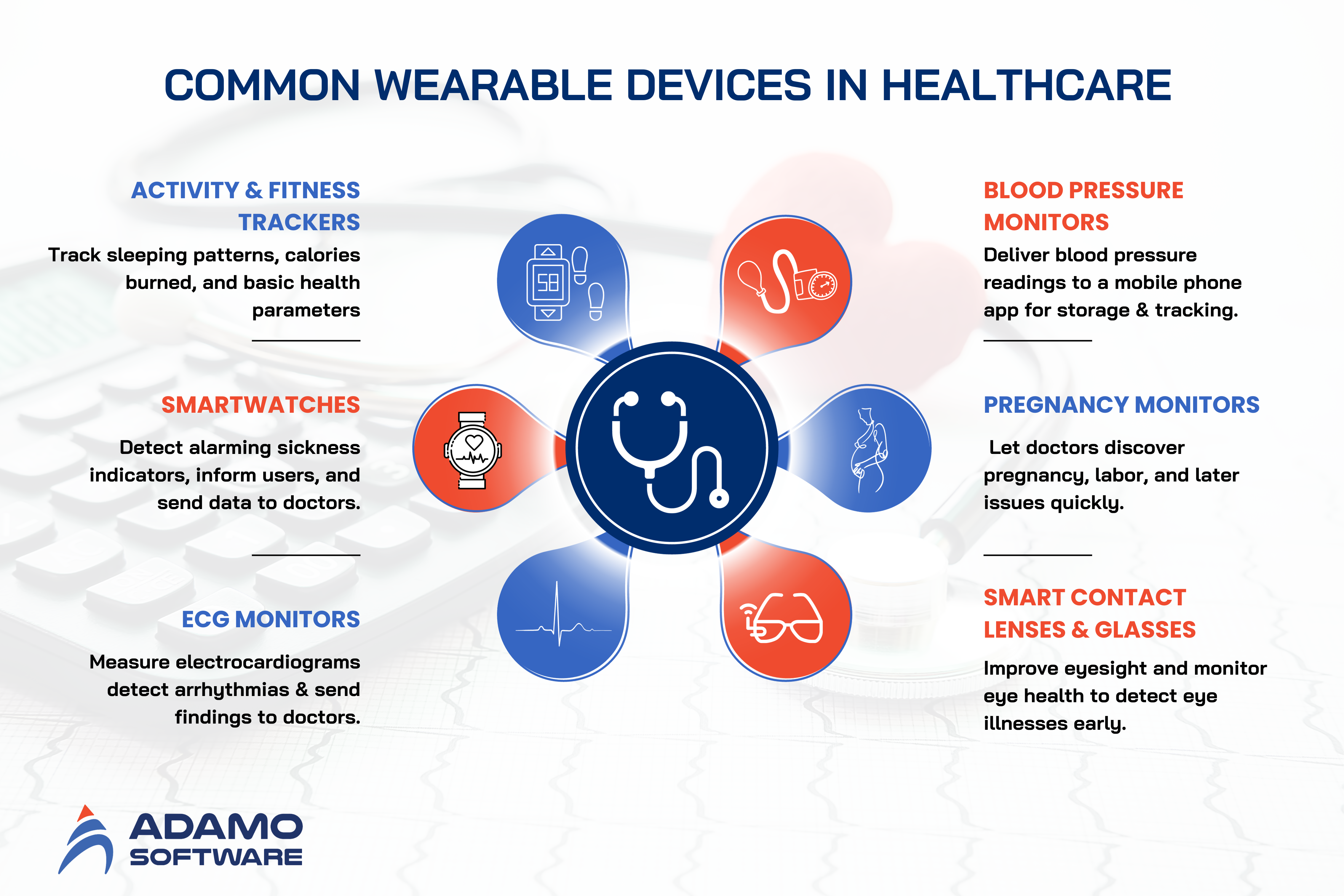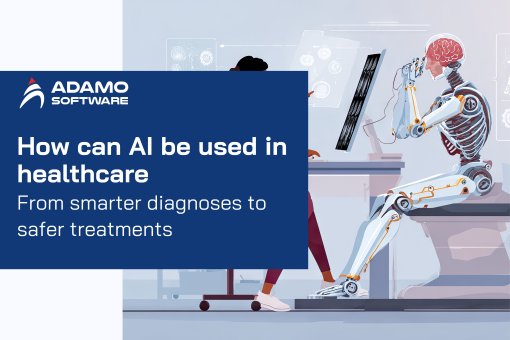Top 18 Wearable Medical Devices Revolutionizing Healthcare

Explore the Top 18 Wearable Medical Devices transforming healthcare! From heart rate monitors to AI-powered health trackers, discover cutting-edge technology enhancing patient care & wellness.
Wearable medical devices have gained prominence in recent years. This technology, with developments in biosensor technology and accuracy, smaller battery sizes, and increased performance, can give users reliable healthcare data that keeps them in control of their own healthcare.
The market for smart wearable medical devices was estimated at $13.8 billion in 2020 and is predicted to grow to $37.4 billion by 2028. Here are 18 wearable medical devices that are transforming the patient’s experience in healthcare with wearable technology.
1. Apple Watch
With the release of the iPhone 6 and Apple Watch, Apple joined the wearable medical device space, offering fitness monitoring, file sharing, and emergency contact information storage.
CEO Tim Cook has expressed his delight that the Apple Watch and AirPods wireless headphones had surpassed the revenue of the iPod.
“On a trailing basis, the revenue for wearable medical devices is already 50% more than iPod was at its peak,” according to Cook. “I think everybody would say it was an incredibly important product for Apple, full of innovation, and probably the trigger for the company getting on a very different trajectory and into other markets.”
2. Dexcom’s Glucose Monitor
Dexcom, a pioneer in diabetes technology, first appeared in 1999. The only way to assess glucose levels back then was a fingerstick, which can be painful, messy, and inconvenient. Many diabetics now prefer to use Dexcom’s wearable medical device, the Continuous Glucose Monitor. Its outstanding features such as:
– Real-time glucose readings
– No fingerstick. No scanning.
– Exceptional accuracy.
– Proven results.
3. Cala Health’s Cala Trio
Hand tremors affect millions of people and can disrupt numerous daily tasks. The Cala Trio is a wrist-worn wearable medical device that is an excellent non-invasive treatment for tremors. The FDA has certified the Calo Trio wearable medical device as an external upper limb tremor stimulator, and it must be prescribed by a doctor.
4. Wearable X’s Yoga Pants
Wearable X combines fashion and technology. The Nadi X yoga pants are equipped with sensors that provide instruction through vibration and audio for people who struggle to complete their preferred yoga positions.
The pants come with a USB charging cable, and a custom-designed storage box, and can be machine-washed and tumble-dried.
Wearable X has collaborated with Durex on Fundawear, which is vibrating underwear for couples, especially those in long-distance relationships.
5. Esper Bionics’ prosthetics
Esper Bionics, a human augmentation startup, combines AI and IoT technology to enable it to personalize its robotic prosthesis to users’ lifestyles.
“Our current goal is to build the biggest connected community of users of large wearables in the world as a foundation for the introduction of electronic implants,” said CEO Anna Believantseva. “We believe it will enhance human abilities, eliminate many diseases, and enable people to live longer and more fulfilling lives in a diverse world. We began by improving the prosthetics business, which is at the heart of this community of major wearables users.”
6. identifyHer
IdentifyHer helps women going through menopause by giving them a smart tracker. Therefore, they can use that tracker to keep track of their symptoms. The tracker uses AI-powered technology to make treatment more personalized and lower the risk of getting sick in the future.
7. Embr Labs’ the Embr Wave
Embr Lab’s wearable thermal technology allows users to heat up and cool down at the touch of a button, allowing people who suffer from temperature control to live their lives more freely.
The Embr Wave is a wearable medical device for the wrist that can help with sleep, anxiety, and hot flashes. CEO Elizabeth Gazda and her team listened to over 70,000 consumers’ feedback to create the ultimate “beautiful” wearable, the Embr Wave.
8. Fitbit
Fitbit is a well-known brand of wearable medical devices that mostly consists of activity trackers. These products are designed to assist you in improving your fitness and health lives.
Fitbit devices collect a wide range of data about your daily physical activities. This information varies by device, but nearly all of them measure your daily steps, distance, calories burnt, and sleeping activities. Some of the more modern gadgets can also monitor your heart rate and track your location using GPS, allowing you to check your route, distance, and pace after a run via the mobile app.
9. Rods & Cones’ smart glasses
The eyeglass was the first wearable medical device, invented in 1284 in Italy. It is estimated that up to 4 billion people need glasses every day to read, drive, text, and go about their daily lives. AR glasses for a more efficient shopping experience and VR glasses for gaming have transformed glasses into more than just regular wear. Rods & Cones smart glasses can transform live surgeries.
With its smart glasses, Rod & Cones provides a unique perspective on the world for medical staff in remote locations. As a result, a doctor in a remote area can be joined by an expert somewhere who can see what they see and advise them when performing a tricky procedure.
10. OURA Ring
If you’re going to market your product as “the world’s greatest sleep tracker,” you’d better be pretty sure it’s a good one. And this is just what the Finnish brand Oura has done. When compared to a medical ECG machine, the Oura Ring has 99.6% resting heart rate accuracy and 98% heart rate variability accuracy in a four-gram wearable.
The wearable medical device takes readings from the palm side of the finger, where pulse signals are strongest, to record the most accurate data, and 86% of Oura Members have reported an increase in their sleep quality.
11. Silvertree Reach
Silvertree, a health tech firm, produces a wearable medical device – The Silvertree Reach – designed to monitor health and safety in older active adults. The Reach wristband is designed to provide elderly people with more independence and comes with a subscription connectivity service that lets the wearer send an emergency signal. This device also has GPS tracking in the event of an emergency and detects falls. The Reach app counts steps, keeps medical records and digital ID available, and allows you to communicate with loved ones.
12. Garmin
Garmin manufactures a wide range of gadgets, including adult and child fitness and health-tracking wearable medical devices. Garmin also provides an all-day activity tracker that counts steps, distance, intensity, and calories to assist customers in meeting their health and fitness objectives. Wearable medical devices from the company, such as the Venu series, measure body rhythms, sleep quality, and heart rate while pairing with Apple and Android smartphones for increased convenience.
13. Ava Women
The Ava bracelet is a night-only wearable medical device that lets women track their cycles naturally to learn more about their fertility, pregnancy, and overall wellness. In addition to easy symptoms, ovulation, and period tracking, the Ava app tracks and logs sleep, stress levels, and resting heart rate.
14. PatientPoint
PatientPoint’s patient engagement solution offerings include remote patient monitoring tech enabled by remote care startup Optimize Health. The PatientPoint claims to collaborate with medical practitioners to determine which patients are qualified before handling logistics for distributing wearable medical devices to patients and onboarding them.
According to the firm, its monitoring technologies enable medical professionals to discover patterns among a patient’s important parameters to make necessary adjustments to their treatment plans, with applications for patients who require preventative cardiac care, for example.
15. Owlet Baby Care
Owlet designs wearables and cameras for babies and infants that monitor heart rates and oxygen levels, measure sleep, and offer audio and video streaming capabilities. The Owlet goods can be tracked via a mobile app and provide weekly milestones in a baby’s development.
16. Abbott – wearable biosensor technology
Abbot offers various services to healthcare consumers and professionals, including physical activity, diabetes, and cardiology. The business has also made significant breakthroughs in the development of glucose sport biosensors.
This biosensor, known as Libre Sense, connects to the back of the upper arm and collects data on glucose levels in athletes aged 16 and higher. Libre Sense is also available over the counter and works with mobile apps to make its data available.
17. L’Oreal’s My Skin Track UV
My Skin Track UV by L’Oreal brand La Roche-Posay is a wearable medical device that links with a mobile app to track a user’s exposure to UV, pollen, humidity, and pollution. It also advises consumers on how to deal with any negative consequences. The sensor is battery-free and available in the App Store.
18. The Quardioarm Blood Pressure Monitor
The Quardioarm Blood Pressure Monitor is the best on the market, with over 2,000 5-star reviews. This monitor is worn on the right or left arm and accurately sends a blood pressure measurement to the user’s phone. The most precise wearable medical device on the market is the at-home blood pressure cuff. Quardioarm Blood Pressure Monitor cuff can link to a smartphone to store blood pressure and pulse data.
Why choose Adamo for building your on-demand healthcare solutions?
Adamo Software, a premier software development company in Vietnam, has a better chance of surpassing all competitors and providing businesses with the attention they need. It is vital to select the correct software development services for on-demand healthcare software solutions that not only deliver commercial value but also provide high security. It’s time to break new ground and work in new ways with modern technologies to deliver cost-effective solutions. We’re always interested in hearing about new ideas and addressing difficult development problems!
FAQs
1. What is wearable healthcare technology?
Wearable healthcare technology refers to health monitoring equipment worn on the body, such as the wrist, to help monitor the wearer’s health data. These devices use biosensors to collect data from the patient, such as heart rate, blood pressure, sleep habits, and activity.
Wearable medical devices have grown in popularity over the years as sensor technology has advanced and the ability to manufacture sensors and batteries very small has become possible.
These devices can precisely monitor fitness, heart rate, overall wellness, and illness management for various reasons. They can also provide medication reminders and save patient health data.
2. What are the future wearable medical devices?
The future of wearable technology in healthcare is bright. Engineers can deliver the greatest and most precise healthcare monitoring to users by using the most accurate sensors and technology. Wearable health technology has the potential to transform healthcare by allowing patients to be more proactive in their health and well-being. However, there is much more to come, and healthcare technology’s future is still in its early phases.
Many excellent wearable healthcare monitoring gadgets on the market enable consumers to precisely measure healthcare data. The Apple Watch is considered the most advanced wristwatch on the market, but other models are not far behind. NADI X, for example, is a new and revolutionary technology that allows users to develop their routines while monitoring their health. Wearable healthcare technology is in its early phases of development, and there is more to come for both new and established brands in the future.
3. Why wearable health monitoring devices are crucial for healthcare solutions?
3.1. Monitoring and managing chronic conditions
Wearable medical devices can be extremely beneficial for people suffering from chronic conditions such as diabetes or heart disease. These gadgets can continuously monitor vital signs and offer data to healthcare providers. Healthcare providers can use this information to discover early warning symptoms and change treatment plans as needed. Moreover, wearable medical devices can assist patients in managing their diseases by reminding them to take medications, measuring their activity levels, and making individualized recommendations.
3.2. Increasing patient engagement
Wearable medical devices can help patients become more involved in their own healthcare. Patients can stay motivated and involved in their health and fitness goals by tracking their progress and witnessing verifiable benefits. Furthermore, wearable medical devices can offer patients crucial health information that they might not have otherwise, such as sleep habits and stress levels.
3.3. Facilitating remote patient monitoring (RPM)
One of the most significant advantages of wearable medical devices is the ability to monitor patients remotely. This means that healthcare providers can monitor patients without requiring them to visit a clinic or hospital. RPM can be very beneficial for those who live in rural or remote places, as well as patients who have mobility limitations.
You can explore more about What is remote patient monitoring? Tech stacks and real-life examples here.
3.4. Improved accuracy in data collection
Wearable medical devices can provide precise, real-time information about a patient’s health and well-being. This is especially useful for people who have chronic diseases since it allows healthcare providers to recognize early warning signs and change treatment programs as needed. Moreover, wearable medical devices can help to reduce human error when patients manually report their health data.
4. What are possible wearable tech challenges?
4.1. Interoperability challenges
Interoperability refers to the capacity of different devices and systems to communicate and exchange data. It is critical in healthcare to ensure that patient data may be shared between different healthcare providers and systems. However, interoperability remains a fundamental barrier for wearable medical devices in healthcare. Many wearable medical devices use multiple data formats, making integration into existing healthcare systems problematic.
4.2. Data transaction challenges
A data transaction is the process of moving data from one system to another. Data transactions are crucial in healthcare to ensure that patient data is accurate and up to date. However, data transaction issues may develop if wearable medical devices do not connect well with existing healthcare systems. This can lead to data accuracy, delays, and other problems.
4.3. Data security and privacy challenges
Data security and privacy are key concerns in healthcare, and wearable technology just adds to the complexity. Wearable medical devices capture and retain sensitive patient data, which might be exposed to hacking and other cyber-attacks. Furthermore, patients may be hesitant to adopt wearable medical devices if they are concerned about their privacy and data security.
4.4. Regulatory challenges
Several regulatory requirements apply to wearable technology, particularly in healthcare. These specifications can differ based on the type of device and its intended application. For example, medical-grade wearable medical devices must meet safety and efficacy standards before they may be used in clinical settings. These regulatory challenges can be a barrier to entry for wearable medical device startups, particularly smaller ones.
5. What are the common wearable devices in healthcare?

5.1. Activity and fitness trackers
These small wristbands with sensors are one of the most popular and affordable wearable technologies. They track sleeping patterns, calories burned, and basic health parameters.
5.2. Smartwatches
Over time, smart health watches have combined smartphone-like call and message capabilities with fitness tracker functionality like activity, stress, sleep, and heart rhythm monitoring. Smartwatches can now detect alarming sickness indicators, inform users, and send data to doctors.
5.3. ECG Monitors
Modern wearable ECG devices may properly measure electrocardiograms detect arrhythmias and send findings to doctors for review.
5.4. Blood pressure monitors
Modern wearable medical devices use more comfortable cuffless technology to deliver blood pressure readings directly to a mobile phone app for storage and tracking. How the user’s habits affect blood pressure might also reveal what’s happening.
5.5. Pregnancy monitors
Wearable medical devices protect mothers and babies. These sensors let doctors discover pregnancy, labor, and later issues quickly.
5.6. Smart contact lenses and glasses
Wearable medical devices are quickly becoming essential healthcare tools for those who have vision loss or impairment. Because of the advancement of smart lenses, these devices are now utilized to improve eyesight and monitor eye health to detect eye illnesses early.
6. What are the top multi-sensor health wearables on the market?
Some top multi-sensor health wearables among our lists are:
6.1. Apple Watch
Most comprehensive: HR, HRV, ECG, SpO₂, skin temp, sleep, activity, VO₂ max.
Best for: All-around health & daily monitoring.
6.2. Oura Ring
Strong in: Sleep, HRV, temp, readiness, recovery.
Best for: 24/7 passive tracking without a bulky device.
6.3. Garmin (Venu/ Fenix/ Forerunner series)
Strong in: HR, HRV, SpO₂, activity, sleep, body battery, stress.
Best for: Athletes and high-accuracy fitness tracking.
6.4. Fitbit (Sense/ Charge series)
Sensors: HR, HRV, SpO₂, stress, sleep.
Best for: Budget-friendly wellness tracking.











